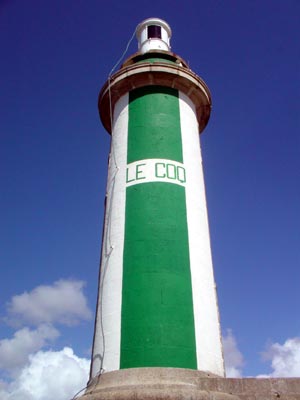 by dawson99 » Mon Feb 20, 2006 12:19 pm
by dawson99 » Mon Feb 20, 2006 12:19 pm
An aid for navigation and pilotage at sea, a lighthouse is a tower building or framework sending out light from a system of lamps and lenses or, in older times, from a fire. More primitive navigational aids were once used such as a fire on top of a hill or cliff .Because of modern navigational aids, the number of operational lighthouses has declined to fewer than 1,500 worldwide. Lighthouses are used to mark dangerous coastlines, hazardous shoals away from the coast and safe entries to harbors.
In order to conserve power, the light is concentrated. In old lighthouses:
vertically the light is bundled into horizontal directions
horizontally the light is bundled into one or a few directions at a time, but sweeping around, so that it can be observed from every horizontal direction
This concentration of light is accomplished with a rotating lens assembly. In very old lighthouses, the light source was a kerosene lamp, and the lenses were rotated by a clockwork assembly wound daily by lighthouse keepers. The lens assembly usually floated in mercury to reduce friction. In more modern lighthouses, electric lights and clock drives were used, generally powered by diesel burning electric generators. These also supplied electricity for the lighthouse keepers.
A modern automated lighthouse on St. Paul IslandEfficiently concentrating the light from an omnidirectional source of the type used in lighthouses requires a lens of very large diameter. This would lead to a very thick and heavy lens if naively implemented. A Fresnel lens is a type of lens developed for lighthouses. Its design enables the construction of lenses of large size and short focal length without the weight and volume of material which would be required in a lens of conventional design. Some lighthouses, such as those at Cape Race, Newfoundland, and Makapu'u Point, Hawaii, used a special hyperradiant lens manufactured by the firm of Chance Bros.
In modern, automated lighthouses, this system of rotating lenses is often replaced by a very bright light that emits brief omnidirectional flashes (concentrating the light in time rather than space). These lights are similar to the aerodrome beacons used to warn aircraft away from tall structures.
The square-shaped lighthouse of Cape Borda, Kangaroo Island, South AustraliaIn any of these designs an observer, rather than seeing a continuous weak light, sees a brighter light during short time intervals. These instants of bright light are arranged to create a characteristic light pattern specific to the particular lighthouse. For example, for the lighthouse of Scheveningen the time intervals between these instants are alternately 2.5 and 7.5 seconds.
Lighthouses have become popular tourist destinations.
Admiralty Head Lighthouse, Whidbey Island, Washington. Inactive, but used as interpretive center by a local environmental groupIn the United States, lighthouses are maintained by the United States Coast Guard. In the United Kingdom, those in England and Wales are looked after by Trinity House, those in Scotland by the Northern Lighthouse Board, and those in all of Ireland by the Commissioners of Irish Lights. In Canada, they are managed by the Canadian Coast Guard. In Australia, lighthouses are looked after by the Australian Maritime Safety Authority.
Perhaps the most famous lighthouse in history is the Lighthouse of Alexandria, built on the island of Pharos in ancient Egypt. The name of the island is still used as the noun for "lighthouse" in some languages, for example French (phare), Italian (faro also has the meaning of "headlight" e.g. in a car), Spanish (faro), Portuguese (farol) and Greek (φάρος). The word "pharology," (the study of lighthouses) is also derived from the island's name.
Strumble Head Lighthouse, WalesBengtskär lighthouse is the highest one (52 meters) in the Nordic countries. It is situated to the south of Hanko, Finland. It was built in 1906 and it is the first lighthouse museum in Finland.
In the beginning of the 20th century Swedish inventor Gustav Dahlén invented the AGA Lighthouse which effectively made lighthouse keepers obsolete. However, for many years lighthouses still had keepers, partly because lighthouse keepers could serve as a rescue service if necessary. Improvements in maritime navigation and safety such as GPS have led to the phasing out of non-automated lighthouses, with the last keepers removed in the 1990s. Today there are a few keeper-run lighthouses left in existence; the vast majority, however, have been fully automated.
In some locations, the lighthouse buildings are being maintained as tourist attractions, but in inaccessible locations, modern lighthouses are being installed. These are much more functional and less picturesque buildings; usually they are solar-powered and have a single flashing light which does not rotate.
The Soviet Union built a number of automated lighthouses powered by radioisotope thermoelectric generators. These now pose serious concerns, as the radioactive material could leak, leading to radioactive contamination, or be stolen and used in a dirty bomb .Some of these lighthouses cannot be found, due to poor record keeping.
0118 999 881 999 119 7253













